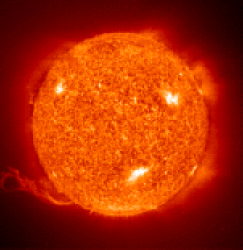|

|
The sun is a nuclear furnace that constantly boils off a gas-like
mixture of charged
sub-atomic particles, electrons, and protons (ions). This zoo of
charged particles is called a "plasma". The plasma state
is often referred to as the fourth state of matter.
Solar flares, coronal mass ejections (CME), and coronal
holes, which occur sporadically, increase the output of these particles.
Therefore, the particles continuously flow outward from the sun with
variable intensity toward the earth.
|






